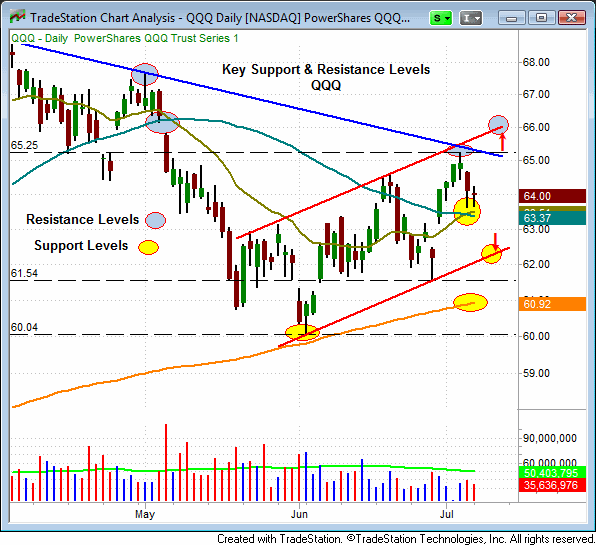Since the stock market appears to be in consolidation mode right now (trading in a sideways range on lighter volume), it is a good time to do a review key technical support and resistance levels in the Nasdaq and S&P 500 indices. Doing so will enable you to be prepared with an action plan for your trading operations when the major indices make their next move.
The following daily chart of Powershares Nasdaq Trust ($QQQ), as an ETF proxy for the Nasdaq 100 Index, shows that the price action in this ETF has been contained by a relatively tight ascending trend channel (annotated by the red lines) since forming its “swing low” support level on June 4. Trend channels such as these provide an excellent gauge for determining support and resistance levels. In this case, the trend channel suggests QQQ should find support near-term support around the $62.40 area and its next near-term resistance near $66.00. Other significant support levels include the convergence of the 20-day and 50-day moving averages ($63.30 – $63.50), the 200-day moving average ($60.92), the June 28th swing low ($61.54) and the June 4th swing low ($60.04).

The SPDR S&P 500 ($SPY) has also formed an ascending trend channel similar to QQQ. The next important resistance levels on SPY are the July 3rd swing high ($37.51) and the upper trend line of the trend channel (see the red “up” arrow near $139.00). Key support levels for SPY include the convergence of the 20 and 50 day moving averages ($134.00 to $134.40), the lower trend channel line near $133.20, the June 25th swing low ($130.85), the 200-day MA ($130.52) and the June 4th swing low of $127.14.

As evidenced by the daily charts of QQQ and SPY above, both of these ETFs, and by extension the broad market, have a considerable number of both near-term support and resistance levels. This suggests that stocks could remain in a trading range throughout the summer, which is seasonally not unusual. With much of Wall Street not working and enjoying summer vacation with their families, there is likely to remain an absence of big volume in the near-term. With a lack of solid turnover, it will probably be difficult for the broad market to make a significant, convincing move in either direction. As such, we wouldn’t be surprised to see a lack of significant movement in the broad market during the low volume summer doldrums. Be careful to avoid overtrading in the current environment; there will be plenty of time for profiting from swing trading ETFs and stocks when volume (and hence conviction) eventually returns to the market. Above all, don’t forget that cash is always a valid position.
The commentary above is an excerpt from today’s Wagner Daily trading newsletter. Click here to start your 30-day risk-free trial subscription and receive the best daily stock picks and ETF trading ideas and technical analysis from our flagship stock newsletter.
